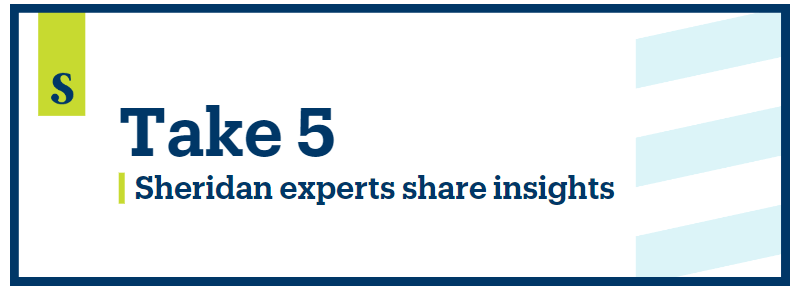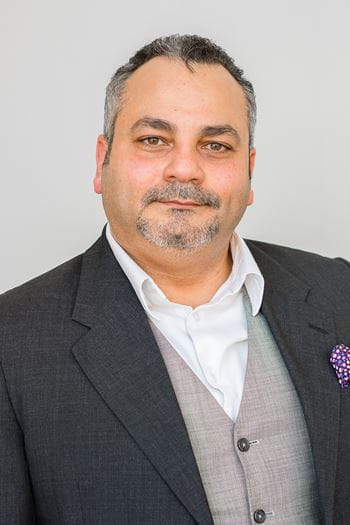
What makes an organization a top employer?
 by Jon Kuiperij – Mar 1, 2023
by Jon Kuiperij – Mar 1, 2023  In Take 5, Sheridan’s thought leaders share their expert insight on a timely and topical issue. Learn from some of our innovative leaders and change agents as they reflect on questions that are top-of-mind for the Sheridan and broader community.
In Take 5, Sheridan’s thought leaders share their expert insight on a timely and topical issue. Learn from some of our innovative leaders and change agents as they reflect on questions that are top-of-mind for the Sheridan and broader community. Earlier this year, Sheridan topped Forbes Magazine’s annual ranking of Canada’s Best Employers — marking the fourth straight year the institution has appeared on the prestigious list. Sheridan also ranked 10th on Forbes’ most recent list of Canada’s Best Employers for Diversity, which did not include any other college in the country.
Earlier this year, Sheridan topped Forbes Magazine’s annual ranking of Canada’s Best Employers — marking the fourth straight year the institution has appeared on the prestigious list. Sheridan also ranked 10th on Forbes’ most recent list of Canada’s Best Employers for Diversity, which did not include any other college in the country.
In this installment of Take 5, Sheridan Pilon School of Business professor Dr. Shady Hana discusses the keys to being considered a top employer, the critical role that Human Resources professionals play in an organization’s success, how the COVID-19 pandemic has impacted HR, the biggest challenges faced by the profession and more.
1 .What sets an organization apart as a top employer or an employer of choice?
Many organizations make the mistake of only being concerned about what’s happening outside, whether that be competitors or clients or the environment. Those are important things to monitor, but the biggest key is not what is happening on the outside, it’s what is happening on the inside.
Investing in learning, rather than investing in training, can make all the difference. McLean and Company’s 2023 HR Trends Report spoke to how three of five employees are leaving organizations due to a lack of visibility of learning and development opportunities. If they can’t see where they might be able to advance in the organization, they often go elsewhere.
“The biggest key is not what's happening on the outside, it is what's happening on the inside... If (employees) can't see where they might be able to advance in the organization, they often go elsewhere.”
Another integral piece is to create your own customized competency framework. Looking at best practices is a good idea, but emulating them isn’t necessarily the best case for your company. For example, Sheridan is in a very unique position to do things in a very different way because we’re not a college and we’re not a university. We’re different. So that puts us in a unique position to create our own competency frameworks and way of doing things that will work for tomorrow and the day after tomorrow.
Fostering diversity, inclusion and equity has always been important, and creating a sense of belonging is just as important — providing an environment in which employees feel safe to engage and grow while also maintaining the organization’s direction. It’s also critical to constantly review your work processes, policies, procedures and governance to make sure they’re sustainable, efficient and equitable across the board.
2. Last year, Sheridan’s employee-centred initiatives included introduction of an e-performance and talent management portal, advancement of its Community Wellness Strategy, and creation of a Flexible Workplace Strategy that incorporates employee feedback. From an HR perspective, what else have you observed that has made Sheridan a top employer?
To borrow a saying from McDonald’s founder Ray Kroc, ‘As long as you’re green, you’re growing.’ To me, that is one of Sheridan’s strengths — that we continue to be green and growing all the time. What we’re doing now is better than what we were doing five years ago.
During my time at Sheridan, I’ve been involved with various initiatives that enhance our community and culture, such as the Sheridan People Awards that celebrate exceptional achievement and commitment to the institution, or defining suggested practices to guide the research of faculty, staff and students when working with Indigenous Peoples.
Currently, I’m part of the Community Connections Committee that consists of representatives from each of our five Faculty Local Academic Councils as well as Carol Altilia, our Provost and Vice-President, Academic. It’s a fantastic investment in cultivating faculty dialogue, professional development and networking opportunities, and the fact that it's linked to Sheridan’s strategic leadership level speaks to how highly Sheridan thinks of that.
3. Why are Human Resources professionals so critical to the success of an organization?
What happens if you use a faulty gauge to ascertain the air pressure in your vehicle’s tires before you go out on the highway? Things may or may not go very well.
The HR department is where you have the gauges, the control and the opportunity to shape your organization. That means you need to be very careful and selective about who you have on your HR team, because they can help ensure you have the right mix of people to sustain a unique culture.
A big issue in HR today is the number of people who claim to be recruiters or talent acquisition specialists but lack a clear understanding of the depth of talent management or its impact on an organization. Imagine the multi-layered damage that hiring the wrong employee can do to your organization, your costs, and your brand. If you intend on hiring somebody or a third party to hire for you, you need to ask them about their credentials and their methodology, because they’re representing your brand and your business.
4. How has the COVID-19 pandemic impacted the world of HR?
I believe that — like any other significant occurrence in life — we will see the pandemic’s effect on workforce participants’ decisions for the next decade or more as they look within and think how they might be able to leverage transferable skills and competencies they already have to do things differently and lead a life that will bring them more happiness.
It’s no longer solely about benefits and compensation. Research has shown that a raise will only motivate most people until they cash their first paycheck, because they now know they can attain that level of compensation and it doesn’t motivate them anymore. People’s situations, circumstances and priorities change over time, which is why listening to what your employees have to say should be core to any future changes you plan to make.
Increased demand for simplicity is another thing that was identified in the most recent round of the RBL Group’s HR Competencies Research. People have had enough with sophistication and having to sift through pages and pages of policies and procedures that protect liability and mitigate institutional risk. It’s on Human Resources Management professionals to find simple ways to listen, plan and execute meaningful engagement spaces for employees and workforce participants — which is also a more equitable way of including everybody.
5. What are the biggest issues or challenges HR professionals will have to overcome in the next five years?
Remote and hybrid work will continue to be a hot topic for the foreseeable future as long as we have employers who insist on looking for office hours instead of productive hours. To me, it’s all about the organization’s culture: do you trust your employees to do what they’re supposed to do within the allocated time or not? It’s as simple as that.
When you do ask your employees to come into the office, make sure you’re using that in-person “together-time” to engage them in activities they cannot do remotely. Otherwise, it’s meaningless to bring people together to do the same type of work they can do elsewhere. Everybody loses in that situation — the employee, the employer and the economy.
It’s also critical for HR professionals to keep up to date with alternative and short-form education such as micro-credentials, badges, nanodegrees, MOOCs (massive open online courses), certificates and micro-masters. This type of education has been a growing trend over the past 20 years, especially when the pandemic motivated governments around the world to quickly create capacity to address shortages and vulnerabilities. Nevertheless, a research study I published last year found that 70% of HR professionals either didn’t know about these alternative credentials or didn’t factor them into their decision-making processes.
These alternative credentials’ ability to access untapped potentials can be very helpful to workforce participants, employers and the economy, and they’re another example of why it’s so important for HR professionals to remain current.
Dr. Shady Hana has been a professor in the Pilon School of Business (PSB) since 2015, where he teaches across all of Sheridan’s Human Resources Management (HRM) programs and is currently seconded as PSB Project Manager, Academic and Business Initiatives.
He’s also the founder and principal consultant of his own HRM, organizational development and business consulting firm; an aspiring researcher; a standing member of the PSB Local Academic Council; Co-Chair of the Sheridan Truth and Reconciliation Working Group; and Adviser to the Human Resources Student Association.
CHRP, CHRL, CPHRC, CT, PCA and PCCP are among the professional designations and certifications held by Shady, who has Doctorate and Masters degrees in business administration and a dual bachelor’s degree in Hotel and People Management.
Interested in connecting with Dr. Shady Hana or another Sheridan expert? Please email communications@sheridancollege.ca
This interview has been edited for length and clarity.
Media Contact
For media inquiries, contact Sheridan’s Communications and Public Relations team.



